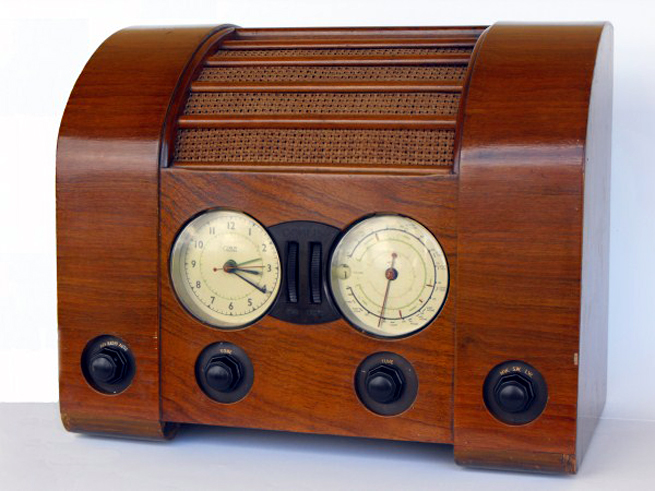General Discussion
Forum home - Go back to General discussion
|
Electric clocks
|
|
|
« Back ·
1 ·
Next »
|
|
|
Return to top of page · Post #: 1 · Written at 8:56:53 PM on 23 September 2013.
|
|
|
|
Administrator
Location: Naremburn, NSW
Member since 15 November 2005 Member #: 1 Postcount: 7590 |
|
A recent discussion on electric clocks, started by a spammer but turned into a proper discussion by some of our regulars, prompted me to rekindling my interest in electric clocks.  This one will hang in my kitchen once I install a new flex and a clockpoint plug on it. My question is, is there enough interest amongst members here for a forum relating to vintage clocks? ‾‾‾‾‾‾‾‾‾‾‾‾‾‾‾‾‾‾‾‾‾‾‾‾‾‾‾‾‾‾‾‾‾‾‾‾‾‾‾‾‾‾‾‾‾‾‾‾‾‾‾‾‾‾‾‾‾‾‾‾‾‾‾‾‾‾‾‾ A valve a day keeps the transistor away... |
|
|
Return to top of page · Post #: 2 · Written at 9:29:03 PM on 23 September 2013.
|
|
|
|
Location: NSW
Member since 10 June 2010 Member #: 681 Postcount: 1389 |
|
I understand that it used to be a function of the grid system control to finesse the system frequency in the early hours to keep synchronous motor clocks on time. I wonder if this still happens in these days of crystal controlled time pieces. |
|
|
Return to top of page · Post #: 3 · Written at 9:52:43 PM on 23 September 2013.
|
|
|
|
Location: Sydney, NSW
Member since 28 January 2011 Member #: 823 Postcount: 6911 |
|
I've got a cheap Chinese Goldair CR909 digital green digits AM/FM clock radio that I bought as an emergency measure at the local pharmacy in 1988 and it's still going strong. |
|
|
Return to top of page · Post #: 4 · Written at 6:33:27 AM on 24 September 2013.
|
|
|
|
Administrator
Location: Naremburn, NSW
Member since 15 November 2005 Member #: 1 Postcount: 7590 |
|
That green display is a valve and they are still in use today in HiFi gear. If you look very closely you'll see two heating elements going across the display and the number segments have a coating of phosphor. ‾‾‾‾‾‾‾‾‾‾‾‾‾‾‾‾‾‾‾‾‾‾‾‾‾‾‾‾‾‾‾‾‾‾‾‾‾‾‾‾‾‾‾‾‾‾‾‾‾‾‾‾‾‾‾‾‾‾‾‾‾‾‾‾‾‾‾‾ A valve a day keeps the transistor away... |
|
|
Return to top of page · Post #: 5 · Written at 7:26:08 AM on 24 September 2013.
|
|
|
|
Location: Cameron Park, NSW
Member since 5 November 2010 Member #: 770 Postcount: 426 |
|
This is a clock radio!  |
|
|
Return to top of page · Post #: 6 · Written at 12:48:15 AM on 3 November 2013.
|
|
|
|
Location: Somewhere, USA
Member since 22 October 2013 Member #: 1437 Postcount: 896 |
|
"That green display is a valve and they are still in use today in HiFi gear. If you look very closely you'll see two heating elements going across the display and the number segments have a coating of phosphor." |
|
|
Return to top of page · Post #: 7 · Written at 8:21:31 AM on 3 November 2013.
|
|
|
|
Location: Canberra, ACT
Member since 23 August 2012 Member #: 1208 Postcount: 587 |
|
So if the 50cycle standard is important to things like the scan rates of CRTs and the spin rate of audio turntables, how would it not be reliable enough for a synchronous clock? |
|
|
Return to top of page · Post #: 8 · Written at 12:22:13 PM on 3 November 2013.
|
|
|
|
Location: Sydney, NSW
Member since 28 January 2011 Member #: 823 Postcount: 6911 |
|
I termed my 1988 clock "old reliable" because it's both. I haven't pulled it apart to see how it's made, nor will I lest I let the Genie out. |
|
|
Return to top of page · Post #: 9 · Written at 12:23:26 PM on 3 November 2013.
|
|
|
|
Location: Sydney, NSW
Member since 28 January 2011 Member #: 823 Postcount: 6911 |
|
|
|
|
Return to top of page · Post #: 10 · Written at 1:19:59 PM on 4 November 2013.
|
|
|
|
Location: Somewhere, USA
Member since 22 October 2013 Member #: 1437 Postcount: 896 |
|
I doubt they are using the mains freq anymore for timing Maven. |
|
|
« Back ·
1 ·
Next »
|
|
|
You need to be a member to post comments on this forum.
|
|

Sign In

Vintage Radio and Television is proudly brought to you by an era where things were built with pride and made to last.
DISCLAIMER: Valve radios and televisions contain voltages that can deliver lethal shocks. You should not attempt to work on a valve radio or other electrical appliances unless you know exactly what you are doing and have gained some experience with electronics and working around high voltages. The owner, administrators and staff of Vintage Radio & Television will accept no liability for any damage, injury or loss of life that comes as a result of your use or mis-use of information on this website. Please read our Safety Warning before using this website.
WARNING: Under no circumstances should you ever apply power to a vintage radio, television or other electrical appliance you have acquired without first having it checked and serviced by an experienced person. Also, at no time should any appliance be connected to an electricity supply if the power cord is damaged. If in doubt, do not apply power.
Shintara - Keepin' It Real · VileSilencer - Maintain The Rage

 Gandhn "This is a clock radio!"
Gandhn "This is a clock radio!"